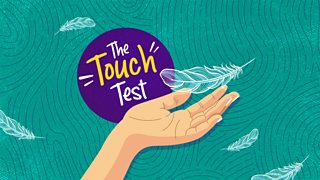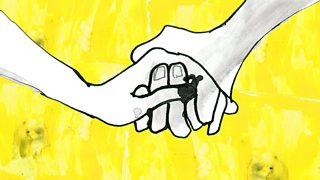Nine things we learned from the world’s largest study of touch
By Claudia Hammond, presenter of Radio 4’s Anatomy of Touch and All in the Mind

Touch is a crucial part of our lives. The right kind of touch can reduce pain, soothe our stress and convey emotion faster than words. It’s a sense that you can’t turn off and we should not underestimate its power.
It’s also a sense that has taken on a new resonance during the pandemic, now that we have to keep our distance and haven’t hugged friends or family we don’t live with for more than half a year.
In January we launched The Touch Test, to find out more about this under-investigated sense. It was an online study commissioned by Wellcome Collection in collaboration with , and it ran until the end of March, a week after lockdown began in the UK. People chose whether to take part, and the findings from those who did show us just how much we value interpersonal touch. You can hear what we discovered in our results programme or read about some of the findings below...
1. Most people like being touched or touching other people, but not everyone does
On a scale measuring people’s attitudes towards touch 72% of people reported positive feelings about touch, while 27% reported negative feelings. So we can’t assume that everyone likes interpersonal touch.
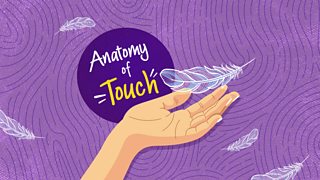
2. People who like interpersonal touch tend to be more extraverted than those who don’t like it
Of all the factors the Touch Test examined, such as age, sex and where in the world people live, personality had the biggest effect on attitudes towards touch. The other factor which made a difference was people’s relationship style. Those who prefer to be independent in their relationships and who can find it hard to get emotionally close to people tended to feel less positive about touch.
3. More than half of people think they don’t have enough touch in their lives
In the survey, 54% of people said they had too little touch in their lives and only 3% said they had too much. It’s important to remember that the Touch Test was open from the end of January to the end of March 2020, so only the last week of data collection took place after the lockdown in the UK. Smaller studies conducted in lockdown have found that now far higher numbers of people feel they are not getting enough touch, suggesting that when we are prevented from hugging and touching our friends and family, we really do miss it.
4. The three most common words used to describe touch are: “comforting”, “warm” and “love”
People from 112 different countries took part in the Touch Test and it’s striking that "comforting" and "warm" were among the three most common words that people used in every region of the world.
5. Almost two thirds of people dislike being touched by a stranger
When people were given a map of the body and asked to indicate where it was OK for a stranger to touch them, the only place they marked was the hand. Bear in mind that almost all the data was collected before most countries locked down.


6. Four times as many women as men sleep better if they don’t touch their partner before they go to sleep
But on the whole most women and most men believed that touch had a positive effect on their sleep, with a stroke or a hug being the most popular form of touch, followed by a massage and then intimate touch.
7. People are divided over whether we touch each other as much as we used to
A third of people said we don’t touch each other as much as we did earlier in their lives but half thought there had been no change.
Those who felt there was a lack of opportunity to touch in modern life were asked why. The most common reason they gave was the issue of consent, followed by a lack of social interaction.
8. People who like interpersonal touch tend to have higher levels of well-being and lower levels of loneliness
The Touch Test took a snapshot in time, so we can’t say which came first – the touch or the higher well-being, but this fits with the findings of many previous studies which have demonstrated that consensual touch is good for us physiologically and psychologically.
9. People would like to use a massage chair, but are not very interested in a device to allow them to shake hands remotely
Around the world there are technological innovations in development to allow people to replace human touch with technology that simulates the touch of another person. But when people were asked whether they would consider using such devices, although some people were very keen, others were not, with 46% saying they would definitely not use technology which would allow them to shake hands with someone via their computer.
The team who created and analysed the Touch Test was led by Prof Michael Banissy from Goldsmiths University of London and included Dr Natalie Bowling from the University of Greenwich, Aikaterini Vafeiadou from Goldsmiths University and Prof Katerina Fotopoulou from UCL.
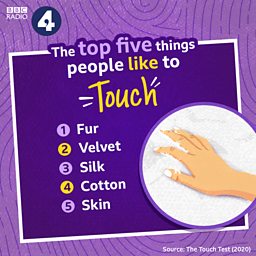
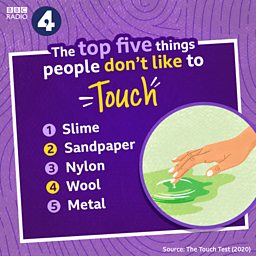

A film about touch from ±«Óãtv Ideas

What happens to humans when we can't touch?
±«Óãtv Ideas explores how touch works and why it's so fundamental to humans
More about touch
-
![]()
Anatomy of Touch
In this five-part series, Claudia Hammond asks whether people have enough touch in their lives and what has been the impact of Covid-19.
-
![]()
Touch Test: The Results
Claudia Hammond reveals the results of the world’s largest study on touch.
-
![]()
'Why I’m not alone in missing hugs during the pandemic'
Claudia Hammond asks how our need for touch has changed because of the pandemic.
-
![]()
Seven amazing things about our sense of touch
Revelations about the way our largest sense organ responds to touch.
